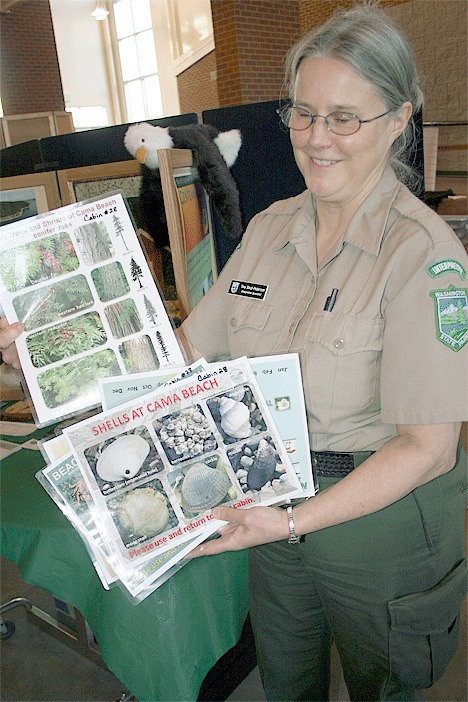Pollution prevention, plastic prohibition and sentinel species played a major part of the 2010 Sound Water Conference in Coupeville last Saturday.
Keynote speaker Dr. Nathaniel Scholz, of the Northwest Fisheries Science Center in Seattle, simplified the intricate Puget Sound environment by explaining the ill-effects of non-point source pollution, otherwise known as toxins that reach the water from non-specific sources.
Decades ago the scientific community worried about point-source pollution, or the kind from major industries that dumped waste directly into the water, said Sarah Woehrman, Island County WSU Beach Watchers coordinator. Today, the biggest concern is individual waste from septics, storm water, household/garden chemicals and pets.
Rain washes non-point-source pollution down storm water drains and into the Sound where the toxins may harm marine life.
Storm water runoff is rapidly becoming the most important pollution threat to the nation’s waterways, according to Scholz.
In the Salish Sea, storm water runoff now carries the greatest amount of toxic chemicals to the Puget Sound, he said. Runoff originates from doorsteps, lawns, streets, parking lots, highways, and almost everywhere else people live, work and pollute.
Regional efforts are now underway to reduce the impacts of polluted runoff, Scholz said.
Some of the methods include low impact development, the use of green infrastructure, and filtration to remove contaminants from storm water, some of which can be seen right here on Whidbey Island.
During a workshop session, the three island mayors — Jim Slowik of Oak Harbor, Nancy Conard of Coupeville and Jim Samuelson of Langley — discussed some of their environmentally-friendly achievements over the last year.
Langley was the first city in Washington to officially adopt low-impact development as part of its planning process and use the low-impact development manual published by the Puget Sound Partnership more than a year ago. Now Oak Harbor plans to include low-impact development standards in its new subdivision and development regulations, which are currently under review.
The island’s northern-most city begrudgingly adopted an unfunded state mandate by the Washington state Department of Ecology last November, which added a new chapter to the city’s storm water management code. The new ordinance makes it illegal to dump anything down a storm drain other than rain.
Oak Harbor also encourages the use of “car wash kits” that divert sudsy water away from storm drains and onto grass, gravel, or other areas where the wash water can evaporate, Slowik said.
Coupeville is exploring the possibility of diverting treated water from its sewage system and stormwater outfalls to Ebey’s Prairie for agricultural use, said Conard.
Only time will reveal the effectiveness of the measures and others put in place by county, city and town government bodies.
In the meantime, Scholz and his colleagues at the National Oceanic and Atmospheric Administration (NOAA) are testing pollution-reducing designs and their ability to lessen toxic contaminants in storm water and keeping a close eye on salmon populations.
Recent scientific findings suggest salmon are a key sentinel species, a kind of “biomonitor” to assess habitat condition and identify any factors that negatively effect an otherwise healthy habitat. Salmon often mirror the success or failure of current strategies, Scholz said.
However, the seventh annual Sound Waters one-day university included more than just talk of storm water. More than 560 attendees, presenters and volunteers partook in 60 classes with topics ranging from sustainability, renewable energy, local history, kayaking and more.
Event staff continued the education process right down to the cups, recycle bins and registration packets.
“We strive to make this a waste-free event,” Woehrman said.
The event volunteers strongly believe in “Reduce, Reuse, Recycle” and track the annual composting and trash disposal quantities from the conference, she said.
Participants are encouraged to bring their own mugs, and many do, she said, adding that new this year was a “Save a Tree” table, where information fliers formerly included in the registration packet were placed.
“We didn’t want to hand out things people might not really want — things they’ll end up throwing away,” Woehrman said.



